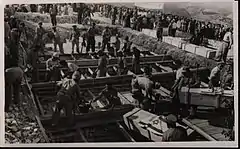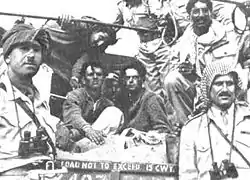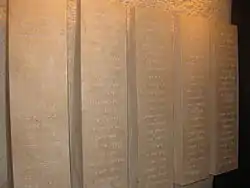Kfar Etzion massacre
The Kfar Etzion massacre refers to a massacre of Jews that took place after a two-day battle in which Jewish Kibbutz residents and Haganah militia defended Kfar Etzion from a combined force of the Arab Legion and local Arab men on May 13, 1948, the day before the Israeli Declaration of Independence. Of the 129 Haganah fighters and Jewish kibbutzniks who died during the defence of the settlement, Martin Gilbert states that fifteen were murdered on surrendering.[1]
| Kfar Etzion massacre | |
|---|---|
| Part of 1947–48 Civil War in Mandatory Palestine | |
 Casualties of the "Convoy of 35" being brought to burial. January 1948 | |
| Location | Kfar Etzion |
| Date | May 13, 1948 |
| Deaths | 129 Jews (fighters and civilians, some murdered after they surrendered) |
| Perpetrators | Arab irregulars |
| Defender | Haganah |
Controversy surrounds the responsibility and role of the Arab Legion in the killing of those who surrendered. The official Israeli version maintains that the kibbutz residents and Haganah soldiers were massacred by local Arabs and the Arab Legion of the Jordanian Army as they were surrendering. The Arab Legion version maintains that the Legion arrived too late to prevent the kibbutz attack by men from nearby Arab villages, which was allegedly motivated by a desire to avenge the massacre of Deir Yassin and the destruction of one of their villages several months earlier.[2] The surrendering Jewish residents and fighters are said to have been assembled in a courtyard, only to be suddenly fired upon; it is said that many died on the spot, while most of those who managed to flee were hunted down and killed.[3]
Four prisoners survived the massacre and were transferred to Transjordan.[3] Immediately following the surrender on May 13, the kibbutz was looted and razed to the ground.[3] The members of the three other kibbutzim of the Gush Etzion surrendered the next day and were taken as POWs to Jordan.
The bodies of the victims were left unburied until, one and a half years later, the Jordanian government allowed Shlomo Goren to collect the remains, which were then interred at Mount Herzl. The survivors of the Etzion Bloc were housed in former Arab houses in Jaffa.[4]
Background
Kfar Etzion was a kibbutz founded in 1943, for military and agricultural ends,[5] about 2 km west of the road between Jerusalem and Hebron. By the end of 1947, there were 163 adults and 50 children living there. Together with three nearby kibbutzim established 1945–1947, it formed Gush Etzion (the Etzion Bloc). According to one member of the settlement, relations were good between settlers and local Arabs, with attendance at each other's weddings, until November 1949.[6]

The United Nations partition plan for Palestine of November 29, 1947 placed the bloc, an enclave in a purely Arab area, inside the boundaries of the intended Arab state,[7] where, moreover, Jewish settlement was to be forbidden through a transitional period.[8] For Hebronite Arabs, the bloc constituted an 'alien intrusion' on ground that had been wholly Arab for centuries,' though it had been built on land either purchased by Jews (1928) or acquired by them through a complex circumvention of Mandatory law in 1942.[9] According to Henry Laurens, Kfar Etzion had started hostilities in the area in December by destroying a local Arab village.[10] On 10 December, a convoy from Bethlehem en route to the Gush Etzion bloc was ambushed and 10 of its 26 passengers and escorts were killed.[5][11] Though on January 5, the children and some women had been evacuated with British assistance, and though David Shaltiel recommended its evacuation,[5] the Haganah, on Yigal Yadin's counsel, decided against withdrawing from the settlements for several reasons: they commanded a strategic position on Jerusalem's southern approach from Hebron,[12] and were considered, in the words of Abdullah Tall, a 'sharp thorn stuck in the heart of a purely Arab area'. Several relief convoys from the Haganah in Jerusalem had been ambushed.
In the months prior to May 15, Haganah militiamen in the bloc's kibbutzim repeatedly fired on Arab civilians, and British traffic, including convoys, moving between Jerusalem and Hebron, under instruction to do so in order to draw and drain Arab forces from the fight for Jerusalem.[13][14] On two occasions, April 12 and May 3, Arab Legion units were ambushed, and several legionnaires killed or wounded[14] by the bloc militias, - Kfar Etzion soldiers being directly involved in the incident on April 12[15] - Arab irregular forces made small-scale attacks against the settlements. An emergency reinforcement convoy attempting to march to Gush Etzion under cover of darkness was discovered and its members killed by Palestinian Arab forces. Despite some emergency flights by an Auster from Jerusalem[5] and Piper Cubs out of Tel Aviv onto an improvised airfield,[4] adequate supplies were not getting in.
As the end of the British Mandate drew closer, the fighting in the region intensified. Although the Arab Legion was theoretically in Palestine under British command, they began to operate more and more independently. On March 27, land communication with the rest of the Yishuv was severed completely when the Nebi Daniel Convoy was ambushed on its return to Jerusalem, and 15 Haganah soldiers died before the remainder were extricated by the British. It was ambushes by the Etzion Bloc militias conducted against Arab Legion units on April 12 and May 4 that, according to a Hanagah analysis, tipped the Legion's policy towards the bloc from one of isolating it to destroying it.[16] On May 4, following the last ambush of a Legion convoy, a joint force of British, Arab Legion and irregular troops launched a major punitive attack on Kfar Etzion. The Haganah abandoned a few outposts but generally resisted, and the attack failed, leaving 12 Haganah soldiers dead, 30 wounded, with a similar number of Arab legionnaires killed, and several dozen wounded. Units from the bloc may have attacked Arab traffic the following day, but the failure of the Legion's assault led Hebronites and Legion units to plan a final attack and destroy the Etzion Bloc militarily.[17] The final assault on Kfar Etzion began on May 12. Parts of two Arab Legion companies, assisted by hundreds of local irregulars, had a dozen armored cars and artillery, to which the Jewish defenders had no effective answer. The commander of Kfar Etzion requested from the Central Command in Jerusalem permission to evacuate the kibbutz, but was ordered to stay. Later in the day, the Arabs captured the Russian Orthodox monastery, which the Haganah used as a perimeter fortress for the Kfar Etzion area, killing twenty-four of its thirty-two defenders.
On May 13, an attack broke through Kfar Etzion's defences and reached the settlement's centre effectively cutting off the perimeter outposts from each other.[18]
Massacre


In the Israeli mainstream version, when the hopelessness of their position became undeniable on May 13, dozens of defenders, the haverim, of Kfar Etzion laid down their arms and assembled in the courtyard, where they suddenly began to be shot at. Those not slain in the first volleys of fire pushed past the Arabs, and either escaped to hide, or gathered their weapons,[19] and were hunted down.[20] The number of people killed and the perpetrators, the Arab legion or local village irregulars or both, are in dispute. According to one account, the main group of about 50 defenders were surrounded by a large number of Arab irregulars, who shouted "Deir Yassin!" and ordered the Jews to sit down, stand up, and sit down again, when suddenly someone opened fire on the Jews with a machine gun and others joined in the killing. Those Jews not immediately cut down tried to run away but were pursued. According to Meron Benvenisti, hand grenades were thrown into a cellar, killing a group of 50 who were hiding there. The building was blown up.[3]
According to other sources, 20 women hiding in a cellar were killed.[21] David Ohana writes that 127 Israeli fighters were killed on the last day.[22]
Arab losses during the two day battle, according to a Haganah estimate, numbered 69: 42 irregulars, and 27 legionnaires.[23] A number of Israeli histories of the Kfar Etzion massacre (such as Levi, 1986, Isseroff, 2005) state that the defenders had put out the white flag and lined up to surrender in front of the school building of the German monastery. An Arab version recounts that a white flag was flown, and drew the Arabs into a trap where they were fired on.[10] Benny Morris cites a Legion officer's statement that the defenders had not formally surrendered, that some resistance continued, with shooting at Arabs, after others had surrendered, that local villagers shot legionnaires trying to defend prisoners, and that legionnaires had to shoot some villagers engaged in the killings.[24] The figure of 127 massacred appears to include both those who surrendered only to be slain, and the defenders who had been killed in battle over 12–13 May.[25]
In another account, after the 133 defenders had assembled, they were photographed by a man in a kaffiyeh, and then an armored car apparently belonging to the Arab Legion opened fire with its machine gun, and then Arab irregulars joined in. A group of defenders managed to crawl into the cellar of the monastery, where they defended themselves until a large number of grenades were thrown into the cellar. The building was then blown up and collapsed on them. About 129 persons died in the battle and its aftermath. Only three of the remaining Kfar Etzion residents and one Palmach member survived. According to their own testimony, the circumstances of their survival were as follows.
- Yaacov Edelstein and Yitzhak Ben-Sira tried to hide amongst a jumble of boulders and branches, but they were discovered by a "wrinkled, toothless, old Arab" who told them "Don't be afraid." Then a group of Arab irregulars rushed up and threw them against a wall. The old Arab tried to shield them with his body. As they argued, two Arab Legionnaires came up and took the two Jews under their protection.
- Nahum Ben-Sira, the brother of Yitzhak, was away from the main group when the massacre started. He hid until nightfall then escaped to a nearby kibbutz.
- Alisa Feuchtwanger (Palmach) tried to hide in a ditch with several others. They were discovered and all were murdered except Alisa, who was dragged away by several Arab irregulars. As the group were trying to rape her, an Arab Legion officer (Captain Hikmat Mihyar) arrived, shot two of the perpetrators and sent the rest away. Afterwards the officer gave her bread, waited until she finished eating, and said to her (quote) "You are under my protection". She testified that while the officer took her to safety, he shot dead wounded Jews.[26]
Both Alisaa and Nahum said that the Legion soldiers actively participated in the Massacre.[26]

A total of 157 defenders died in the battle of Gush Etzion (Levi, 1986), including those killed in the massacre at Kfar Etzion. About 2/3 of them were residents and the remainder were Hagana or Palmach soldiers.
On the following day, the Arab irregular forces continued their assault on the remaining three Etzion settlements. Fearing that the defenders might suffer the same fate as those of Kfar Etzion, Zionist leaders in Jerusalem negotiated a deal for the surrender of the settlements on condition that the Arab Legion protected the residents. The Red Cross took the wounded to Jerusalem, and the Arab Legion took the remainder as prisoners of war. In March 1949 320 prisoners from the Etzion settlements were released from the "Jordan POW camp at Mafrak", including 85 women.[27]
Aftermath
On October 28, 1948, the Arab village al-Dawayima was conquered by the IDF 89th Commando Battalion. They then committed the Al-Dawayima massacre, as the villagers were blamed for the Kfar Etzion massacre. Estimates of the number of murdered Arab villagers range from 80–100 to 100–200, depending on the source.[28][29]
The bodies of the murdered of Kfar Etzion were left at the site for a year and a half, until in November 1949, the Chief Military Rabbi, Shlomo Goren was allowed to collect their bones. They were buried in a full military funeral on November 17 in Mount Herzl in Jerusalem. Their communal grave was the first grave in what is today the military cemetery of Mount Herzl.
The Etzion Bloc became a symbol of Zionist heroism and martyrdom among Israelis immediately after its fall, and this importance continues. The date of the massacre was enshrined as Israel's Day of Remembrance.
The site of the Etzion Bloc was recaptured by Israel during the 1967 war. The children who had been evacuated from the Bloc in 1948 led a public campaign for the Bloc to be resettled, and Prime Minister Levi Eshkol gave his approval. Kfar Etzion was re-established as a kibbutz in September 1967, as the first Israeli settlement in the West Bank after the war.
See also
References
- Martin Gilbert, Jerusalem - Illustrated History Atlas,, V. Mitchell 1994, page 93.
- Henry Laurens, La Question de Palestine, vol.2, Fayard 2007 p.96.:'According to the Arab Legion version, the Jordanian soldiers arrived too late to impede the massacre by villagers who were keen to avenge Deir Yassin and the losses they had sustained since November (it should be kept in mind that it was the colony that opened hostilities in December by destroying a nearby village)'. Selon la version de la Légion, les soldats jordaniens sont arrivés trop tard pour empêcher le massacre de la part des villageois désireux de venger Deir Yassin et leurs pertes depuis le mois de novembre (il faut rappeler que c'est la colonie qui a ouvert les hostilités en décembre en détruisant un village voisin).' Laurens adds:'Le plus probable est que tout se soit passé dans la plus grande confusion' (Most probably, everything took place in a situation of enormous confusion.)
- Meron Benvenisti,"Sacred Landscape: The Buried History of the Holy Land since 1948, University of California Press, 2000 p.116
- Gershom Gorenberg, Occupied Territories: The Untold Story of Israel's Settlements,I.B.Tauris, 2007 p. 20.
- Larry Collins, Dominique Lapierre, O Jerusalem,(1972) Granada Books 1982, p. 217
- Margalit Zisman, cited Michael Petrou, Is This Your First War?: Travels Through the Post-9/11 Islamic World, Dundurn, 2012 p. 167
- Avi Shlaim, 'Israel and the Arab Coalition in 1948,' in Albert H. Hourani,Phillip Khoury,Mary Christina Wilson (eds.)The Modern Middle East, I.B.Tauris, 2nd ed. (2005), pp. 535-56.
- Benny Morris, The Birth of the Palestinian Refugee Problem Revisited, Cambridge University Press, 2004, p. 370.
- Larry Collins, Dominique Lapierre, O Jerusalem,(1972) Granada Books 1982 p.216.'In 1942, by a complex legal manoeuvre, the Fund circumvented the restrictions on Jewish land purchases set out by the British government's 1939 White Paper and acquired the land of a nearby German monastery whose monks had been interned as enemy aliens by the British. On an April night one year later, three women and ten men slipped through the darkness to lay claim to the monastery and officially establish the settlement of Kfar Etzion.'
- Henry Laurens (scholar), La Question de Palestine, vol.2, Fayard 2007 p.96.
- Yoav Gelber,Palestine, 1948: War, Escape and the Emergence of the Palestinian Refugee Problem,Sussex University Press p.26.
- Mark Daryl Erickson, Joseph E. Goldberg, Stephen H. Gotowicki, Bernard Reich, Sanford R. Silverburg (1996). An Historical Encyclopedia of the Arab-Israeli Conflict, p. 149. Greenwood; ISBN 0-313-27374-X
- Henry Laurens, La Question de Palestine, Fayard 2007, p. 96.
- Benny Morris, The Road to Jerusalem: Glubb Pasha, Palestine and the Jews, I.B.Tauris, 2003, pp. 135-37.
- Chronology of International Events and Documents, Volume 4 Royal Institute of International Affairs, 1947 p.270:'12 April. — Jews in the Kfar Etzion settlement near the Jerusalem-Tel Aviv road fired on an Arab convoy and the Arabs fought back.'
- Benny Morris,The Road to Jerusalem, p. 137.
- Benny Morris,The Road to Jerusalem, pp. 137-38.
- B. Morris, The Road to Jerusalem: Glubb Pasha, Palestine and the Jews. pp. 135-38, 2003.
- Dov Knohl,Siege in the Hills:: The Battle of the Etzion Bloc, T. Yoseloff, 1958, p. 334.
- Benny Morris, The Road to Jerusalem: Glubb Pasha, Palestine and the Jews,pp. 138-39
- Ruth Gruber ,Israel on the seventh day, Hill and Wang, 1968 p.30.'Twenty women who had hidden in a cellar were massacred by Arabs with hand grenades.'
- David Ohana, The Origins of Israeli Mythology: Neither Canaanites Nor Crusaders, Cambridge University Press, 2012, p. 104.
- Benny Morris, ibid. p269 n.398.
- Benny Morris, The Road to Jerusalem: Glubb Pasha, Palestine and the Jews, p.139.
- Benny Morris, ibid. p269 n.398.
- Benny Morris (October 3, 2003). The Road to Jerusalem: Glubb Pasha, Palestine and the Jews. I.B.Tauris. p. 139. ISBN 978-1-86064-989-9.
- Moshe Dayan, 'The Story of My Life'. ISBN 0-688-03076-9. Page 130. Out of a total of 670 prisoners released.
- Benny Morris (2008), 1948: An History the First Arab-Israeli War, p. 333
- Saleh Abdel Jawad (2007), Zionist Massacres: the Creation of the Palestinian Refugee Problem in the 1948 War, in E. Benvenisti & al, Israel and the Palestinian Refugees, Berlin, Heidelberg, New-York : Springer, pp. 59-127
Bibliography
- L. Collins and D. Lapierre, O Jerusalem!, Grafton Books, 1982, ISBN 0-586-05452-9.
- I. Levi, Jerusalem in the War of Independence ("Tisha Kabin" - Nine Measures - in Hebrew) Maarachot - IDF, Israel Ministry of Defence, 1986. ISBN 965-05-0287-4
- D. Ohana, Kfar Etzion: the Community of Memory and the myth of return, Israel Studies, vol. 7 no. 2 (2002) 145–174.
- J. C. Lehr and Y. Katz, Heritage Interpretation and Politics in Kfar Etzion, Israel, International Journal of Heritage Studies, Vol. 9, No. 3, 2003, 215–228.
- B. Morris, The Road to Jerusalem: Glubb Pasha, Palestine and the Jews, I.B. Tauris (2003), ISBN 1-86064-989-0.